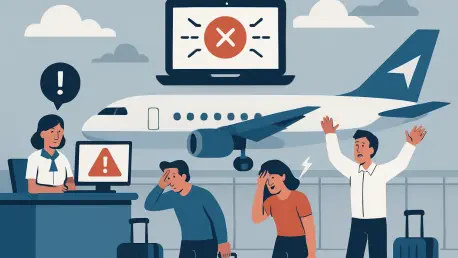The airline industry has embraced a digital transformation that streamlines operations and enhances passenger experiences, but this reliance on technology comes with a hidden danger that investors cannot ignore. Recent high-profile IT outages at major carriers like United and Alaska Airlines have revealed the fragility of these systems, resulting in grounded flights, significant financial losses, and eroded customer trust. These disruptions are more than just temporary setbacks; they signal deeper systemic issues that could jeopardize the stability of investments in the sector. As airlines become increasingly dependent on complex digital infrastructure to manage everything from ticketing to flight scheduling, the potential for costly failures grows. This article explores the financial and operational risks posed by IT vulnerabilities in the airline industry, delving into their root causes and offering insights into how investors can navigate this turbulent landscape.
Unpacking the Financial Impact of IT Failures
Immediate Costs of Operational Disruptions
The financial repercussions of IT outages in the airline industry are both immediate and severe, often leaving carriers scrambling to cover unexpected expenses. A notable incident in July involved Alaska Airlines, where a three-hour system failure led to the cancellation of 200 flights and a projected earnings reduction of 10 cents per share for the quarter. Similarly, United Airlines faced a crisis in August when its outdated Unimatic system malfunctioned, grounding 35% of its flights and canceling 76, while also forcing a downward revision of its earnings forecast by over $2 per share. These events highlight direct costs such as customer compensation, overtime for staff, and lost ticket revenue. Historical cases, like Southwest’s $140 million penalty from a past meltdown, further illustrate how quickly these expenses accumulate, directly impacting profitability and diminishing returns for shareholders who expect consistent performance.
Beyond the initial financial blow, these disruptions often trigger a cascade of logistical challenges that amplify the damage. When flights are canceled or delayed, airlines must rebook passengers, sometimes on rival carriers, and manage the fallout of stranded travelers. This not only inflates operational costs but also strains resources as staff work extended hours to restore normalcy. The ripple effect can extend to supply chain disruptions, with catering, fuel, and maintenance schedules thrown into disarray. For investors, these incidents are a stark reminder that IT failures are not just technical glitches but significant financial events that can alter a company’s quarterly outlook. The unpredictability of such outages adds an extra layer of risk, as even well-managed airlines can find themselves vulnerable to sudden, costly interruptions that erode bottom-line results.
Long-Term Damage to Brand and Market Position
The indirect costs of IT outages often linger long after the systems are back online, as reputational damage can fundamentally alter customer perceptions. When passengers are left stranded, as seen with Alaska Airlines’ 15,600 affected travelers in July, many turn to competitors for future bookings, leading to sustained revenue losses. Negative publicity from these events spreads rapidly through social media and news outlets, amplifying the perception of unreliability. This erosion of trust is particularly damaging in an industry where customer loyalty drives repeat business and long-term profitability. For investors, a tarnished brand image translates into diminished market confidence, as the public’s frustration with an airline can directly influence its financial recovery and growth potential over time.
Moreover, regulatory scrutiny often follows major IT disruptions, adding another layer of financial and operational burden. Penalties imposed by aviation authorities, as evidenced by Southwest’s hefty fines in past years, serve as a reminder that governments hold airlines accountable for service failures. These fines, combined with potential lawsuits from affected passengers, create additional costs that weigh on balance sheets. For stakeholders, the long-term implications are clear: a single outage can reshape an airline’s competitive standing, as customers and regulators alike demand accountability. This ongoing pressure to rebuild trust and comply with stricter oversight can divert resources from growth initiatives, further complicating the investment landscape and highlighting the hidden costs of IT vulnerabilities.
Exploring the Root Causes of IT Vulnerabilities
Challenges with Aging Systems and Vendor Reliance
At the core of many airline IT disruptions lie outdated legacy systems that struggle to meet the demands of modern aviation operations. Platforms like United’s Unimatic, which dates back decades, remain critical to daily functions such as weight and balance calculations, yet lack the flexibility to adapt to current technological standards. These aging systems are prone to breakdowns, as their architecture was not designed to handle today’s volume of data or integration requirements. The result is a heightened risk of failure during peak operational periods, leaving airlines exposed to costly interruptions. For investors, the persistence of such outdated infrastructure signals a lack of proactive modernization, raising concerns about an airline’s ability to maintain operational stability in a competitive market.
Compounding this issue is the industry’s heavy dependence on third-party vendors for critical IT services, which introduces additional points of failure. A prime example is Alaska Airlines’ recent outage, traced to a hardware failure in a multi-redundant system managed by an external provider. Such reliance means that airlines often lack full control over their own infrastructure, making them vulnerable to issues outside their immediate oversight. When vendors fail to deliver, the consequences ripple through an airline’s operations, from booking systems to flight scheduling. This dependency creates a complex risk profile for investors, as it becomes difficult to predict or mitigate disruptions stemming from external partners. The combination of legacy tech and vendor reliance underscores a systemic fragility that demands urgent attention from airline leadership to protect shareholder value.
Rising Concerns Over Cyber Threats
The specter of cyberattacks adds a critical dimension to the IT challenges facing airlines, with potential consequences far beyond technical glitches. The FBI has issued warnings about state-sponsored groups like Salt Typhoon targeting critical infrastructure, a threat brought into sharp focus by Hawaiian Airlines’ cyber breach in June. Such incidents reveal how vulnerable digital systems are to malicious interference, even if not every outage results from an attack. The possibility of data theft, ransomware, or system sabotage poses a significant risk to operational continuity, as airlines store sensitive passenger information and manage vast networks of interconnected systems. For investors, the financial implications of a major cyber incident—ranging from recovery costs to legal liabilities—represent an unpredictable and potentially devastating threat.
Addressing cyber vulnerabilities requires substantial investment in robust defenses, yet many airlines lag behind in this area due to budget constraints or competing priorities. The complexity of securing legacy systems, often not built with modern cybersecurity in mind, further complicates the issue. A successful attack could not only disrupt operations but also damage public trust, as customers worry about the safety of their personal data. Regulatory bodies are increasingly demanding stricter cybersecurity measures, and non-compliance can lead to penalties that strain financial resources. For those with stakes in the sector, the growing cyber threat landscape serves as a reminder that IT risks are not just about hardware or software failures but also about safeguarding against deliberate, hostile actions that could reshape an airline’s future.
Navigating Investment Risks and Opportunities
Effects on Stock Performance and Sector Stability
IT disruptions in the airline industry have a measurable impact on stock valuations, reflecting broader concerns about operational reliability. United Airlines, for instance, has seen its stock decline by 8.7% year-to-date as of August, a direct consequence of recurring system failures and their financial fallout. This drop mirrors a wider trend of heightened market volatility within the sector, as evidenced by the rising beta coefficient—a key indicator of risk relative to the broader market. Investors face increased uncertainty when IT issues lead to earnings downgrades and operational instability, as these events signal potential long-term challenges. The connection between digital reliability and financial performance is undeniable, making IT health a critical factor in assessing an airline’s investment worthiness.
The broader implications of these disruptions extend to overall sector stability, as frequent outages fuel skepticism among shareholders. When major carriers struggle with IT reliability, it casts a shadow over the entire industry, prompting investors to question the resilience of even well-performing airlines. This collective unease can suppress stock prices across the board, as market sentiment shifts toward caution. The loss of customer loyalty, often a byproduct of these incidents, further exacerbates the issue by threatening future revenue streams. For those invested in the sector, understanding the interplay between IT failures and market dynamics is essential, as it highlights how a single outage can influence not just one company but the industry’s broader appeal to capital markets.
Practical Steps for Risk Management
To mitigate the risks associated with airline IT vulnerabilities, investors must adopt a strategic approach that prioritizes due diligence and diversification. Focusing on carriers with transparent plans for IT modernization is a prudent first step, as these companies are better positioned to avoid the pitfalls of outdated systems. Examining earnings guidance for signs of operational weaknesses can also provide early warnings of potential disruptions. Additionally, compliance with regulatory frameworks like the Cybersecurity Maturity Model Certification (CMMC) serves as a benchmark for assessing an airline’s commitment to digital security. By targeting investments in airlines that demonstrate foresight in these areas, stakeholders can reduce exposure to the financial shocks that often accompany IT failures.
Diversifying investment portfolios offers another layer of protection against sector-specific risks inherent in the airline industry. Spreading capital across different industries can cushion the impact of an airline’s IT-related downturn, ensuring that a single outage does not derail overall returns. Staying informed about emerging cyber threats and industry trends is equally important, as it enables investors to anticipate challenges before they materialize. Engaging with analyst reports and industry updates can provide valuable insights into which carriers are leading in IT resilience. Ultimately, a balanced and proactive strategy allows investors to navigate the uncertainties of this digital landscape, capitalizing on growth opportunities while safeguarding against the turbulence of technological vulnerabilities.









